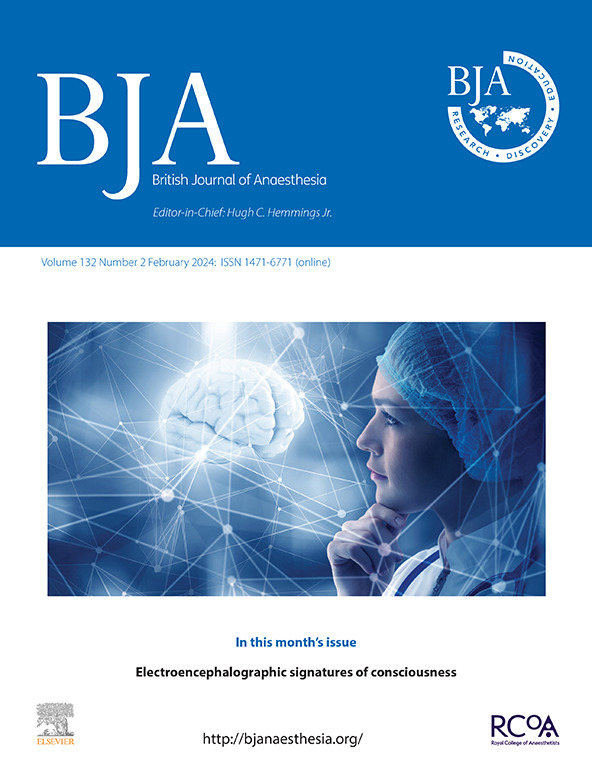英国老年虚弱和多病患者的术后结局:SNAP-3,一项快照观察性研究。
IF 9.2
1区 医学
Q1 ANESTHESIOLOGY
引用次数: 0
摘要
背景:老年外科患者比年轻外科患者住院时间更长,发病率和死亡率风险更高。虚弱(19.6%)和多发病(63.1%)增加了这些风险。第三次冲刺国家麻醉项目(SNAP-3)描述了虚弱和多病对术后结果的影响。方法:我们在2022年进行了一项为期5天的前瞻性观察队列研究,旨在招募所有年龄≥60岁接受手术(不包括小手术)的英国患者。数据包括患者特征、临床变量、临床虚弱量表(CFS)、多病(两种或两种以上合并症)、住院时间(LOS)、术后谵妄、发病率和死亡率。采用分位数回归和混合效应logistic回归分析关系。结果:纳入214家医院7129例患者。衰弱的增加与更长的LOS、更高的谵妄、发病率和≥1年的死亡率相关,CFS明显增加了4%(占队列的19.0%)。在没有多重疾病的患者中,CFS评分为4分的患者入院时间比非虚弱患者更长(平均LOS长0.75天,95%可信区间[CI] 0.34-1.16), CFS评分为5分的患者入院时间长2.69天(95% CI 0.76-4.62)。多病使术后发病率增加46%(校正优势比1.46,95% CI 1.24-1.73),但没有证据表明多病影响LOS、谵妄或死亡率。结论:SNAP-3强调了虚弱对术后预后的影响。多病的影响较小,对术后发病率的影响是唯一有强有力统计证据的影响。这些情况的影响必须与考虑手术干预的老年患者讨论。本文章由计算机程序翻译,如有差异,请以英文原文为准。
Postoperative outcomes in older patients living with frailty and multimorbidity in the UK: SNAP-3, a snapshot observational study
Background
Older surgical patients experience longer hospital stays and a higher risk of morbidity and mortality than their younger counterparts. Frailty (19.6% of cohort) and multimorbidity (63.1% of cohort) increase these risks. The 3rd Sprint National Anaesthesia Project (SNAP-3) describes the impact of frailty and multimorbidity on postoperative outcomes.
Methods
We conducted a prospective observational cohort study over 5 days in 2022 aiming to recruit all UK patients aged ≥60 yr undergoing surgery (excluding minor procedures). Data included patient characteristics, clinical variables, Clinical Frailty Scale (CFS), multimorbidity (two or more comorbidities), length of stay (LOS), postoperative delirium, morbidity, and mortality. Quantile regression and mixed effects logistic regression were used to analyse relationships.
Results
We recruited 7129 patients from 214 hospitals. Increasing frailty was associated with longer LOS, higher odds of delirium, morbidity, and mortality ≥1 yr, with a clear increase noted from CFS of 4 (19.0% of cohort). Amongst those without multimorbidity, individuals with CFS score of 4 had longer admissions than non-frail individuals (median LOS 0.75 days longer, 95% confidence interval [CI] 0.34–1.16), increasing to 2.69 days longer for CFS 5 (95% CI 0.76–4.62). Multimorbidity increased the odds of postoperative morbidity by 46% (adjusted odds ratio 1.46, 95% CI 1.24–1.73), but there was no evidence for multimorbidity impacting LOS, delirium, or mortality.
Conclusions
SNAP-3 highlights the impact of frailty on postoperative outcomes. Multimorbidity had less impact, with an effect on postoperative morbidity the only one to have strong statistical evidence. The impact of these conditions must be discussed with older patients considering surgical intervention.
求助全文
通过发布文献求助,成功后即可免费获取论文全文。
去求助
来源期刊
CiteScore
13.50
自引率
7.10%
发文量
488
审稿时长
27 days
期刊介绍:
The British Journal of Anaesthesia (BJA) is a prestigious publication that covers a wide range of topics in anaesthesia, critical care medicine, pain medicine, and perioperative medicine. It aims to disseminate high-impact original research, spanning fundamental, translational, and clinical sciences, as well as clinical practice, technology, education, and training. Additionally, the journal features review articles, notable case reports, correspondence, and special articles that appeal to a broader audience.
The BJA is proudly associated with The Royal College of Anaesthetists, The College of Anaesthesiologists of Ireland, and The Hong Kong College of Anaesthesiologists. This partnership provides members of these esteemed institutions with access to not only the BJA but also its sister publication, BJA Education. It is essential to note that both journals maintain their editorial independence.
Overall, the BJA offers a diverse and comprehensive platform for anaesthetists, critical care physicians, pain specialists, and perioperative medicine practitioners to contribute and stay updated with the latest advancements in their respective fields.

 求助内容:
求助内容: 应助结果提醒方式:
应助结果提醒方式:


